From inside (document excerpt):
IMPORTANT MANUAL Do Not Throw Away OWNER’S MANUAL MODEL NUMBER: SNOW THROWER PP414EPS30 Read the Owner’s Manual and follow all Warnings and Safety Instructions. Failure to do so can result in serious injury. WARNING: Always Wear Eye Protection During Operation 437953 08.25.10 JA Printed in U.S.A. Safe Operation Practices for Walk-Behind Snow Throwers This snow thrower is capable of amputating hands and feet and throwing objects. Failure to observe the following safety instructions could result in serious injury.
Snow Blower and Snow Thrower User Manual Free Download. Snow Removal Operator’s Manual. Free Instruction Manual Download PDF. Revision: 2010.
Look for this symbol to point out important safety precautions. It means CAUTION!!! BECOME ALERT!!! YOUR SAFETY IS INVOLVED. WARNING: Always disconnect spark plug wire and place it where it cannot contact plug in order to prevent accidental starting when setting up, transporting, adjusting or making repairs. WARNING: This snow thrower is for use on sidewalks, driveways and other ground level surfaces. Caution should be exercised while using on sloping surfaces. Do not use snow thrower on surfaces above ground level such as roofs of residences, garages, porches or other such structures or buildings. WARNING: Snow throwers have exposed rotating parts, which can cause severe injury from contact, or from material thrown from the discharge chute. Keep the area of operation clear of all persons, small children and pets at all times including startup. CAUTION: Muffler and other engine parts become extremely hot during operation and remain hot after engine has stopped. To avoid severe burns on contact, stay away from these areas. WARNING: Engine exhaust, some of its constituents, and certain vehicle components contain or emit chemicals known to the State of California to cause cancer and birth defects or other reproductive harm. (f) Keep the nozzle in contact with the rim of the fuel tank or container opening at all times, until refueling is complete. Do not use a nozzle lock-open device. (g) Replace gasoline cap securely and wipe up spilled fuel. (h) If fuel is spilled on clothing, change clothing immediately. Use extension cords and receptacles as specified by the manufacturer for all units with electric drive motors or electric starting motors. Adjust the collector housing height to clear gravel or crushed rock surface. Never attempt to make any adjustments while the engine (motor) is running (except when specifically recommended by manufacturer). Always wear safety glasses or eye shields during operation or while performing an adjustment or repair to protect eyes from foreign objects that may be thrown from the machine. IMPORTANT Training 1. Read, understand and follow all instructions on the machine and in the manual(s) before operating this unit. Be thoroughly familiar with the controls and the proper use of the equipment. Know how to stop the unit and disengage the controls quickly. 2. Never allow children to operate the equipment. Never allow adults to operate the equipment without proper instruction. 3. Keep the area of operation clear of all persons, particularly small children. 4. Exercise caution to avoid slipping or falling, especially when operating the snow thrower in reverse. 5. 6. 7. 8. Preparation 1. Thoroughly inspect the area where the equipment is to be used and remove all doormats, sleds, boards, wires, and other foreign objects. 2. Disengage all clutches and shift into neutral before starting the engine (motor). 3. Do not operate the equipment without wearing adequate winter garments. Avoid loose fitting clothing that can get caught in moving parts. Wear footwear that will improve footing on slippery surfaces. 4. Handle fuel with care; it is highly flammable (a) Use an approved fuel container. (b) Never add fuel to a running engine or hot engine. (c) Fill fuel tank outdoors with extreme care. Never fill fuel tank indoors. (d) Never fill containers inside a vehicle or on a truck or trailer bed with a plastic liner. Always place containers on the ground, away from your vehicle, before filling. (e) When practical, remove gas-powered equipment from the truck or trailer and refuel it on the ground. If this is not possible, then refuel such equipment on a trailer with a portable container, rather than from a gasoline dispenser nozzle. Operation 1. Do not put hands or feet near or under rotating parts. Keep clear of the discharge opening at all times. 2. Exercise extreme caution when operating on or crossing gravel drives, walks, or roads. Stay alert for hidden hazards or traffic. 3. After striking a foreign object, stop the engine (motor), remove the wire from the spark plug, disconnect the cord on electric motors, thoroughly inspect the snow thrower for any damage, and repair the damage before restarting and operating the snow thrower. 4. If the unit should start to vibrate abnormally, stop the engine (motor) and check immediately for the cause. Vibration is generally a warning of trouble. 5. Stop the engine (motor) whenever you leave the operating position, before unclogging the collector/impeller housing or discharge chute, and when making any repairs, adjustments or inspections. 2 6. When cleaning, repairing or inspecting the snow thrower, stop the engine and make certain the collector/impeller and all moving parts have stopped. Disconnect the spark plug wire and keep the wire away from the plug to prevent someone from accidentally starting the engine. 7. Do not run the engine indoors, except when starting the engine and for transporting the snow thrower in or out of the building. Open the outside doors; exhaust fumes are dangerous. 8. Exercise extreme caution when operating on slopes. 9. Never operate the snow thrower without proper guards, and other safety protective devices in place and working. 10. Never direct the discharge toward people or areas where property damage can occur. Keep children and others away.
Wikipedia’s page for Poulan
Publisher: www.poulanpro.com


 Poulan Pro Owners Manual, 2010 - 1 of 44
Poulan Pro Owners Manual, 2010 - 1 of 44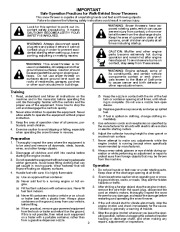 Poulan Pro Owners Manual, 2010 - 2 of 44
Poulan Pro Owners Manual, 2010 - 2 of 44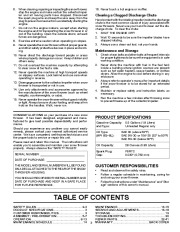 Poulan Pro Owners Manual, 2010 - 3 of 44
Poulan Pro Owners Manual, 2010 - 3 of 44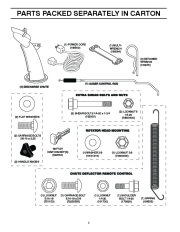 Poulan Pro Owners Manual, 2010 - 4 of 44
Poulan Pro Owners Manual, 2010 - 4 of 44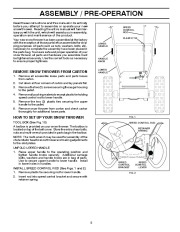 Poulan Pro Owners Manual, 2010 - 5 of 44
Poulan Pro Owners Manual, 2010 - 5 of 44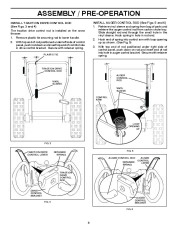 Poulan Pro Owners Manual, 2010 - 6 of 44
Poulan Pro Owners Manual, 2010 - 6 of 44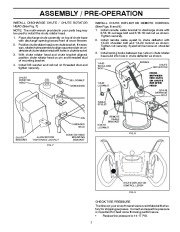 Poulan Pro Owners Manual, 2010 - 7 of 44
Poulan Pro Owners Manual, 2010 - 7 of 44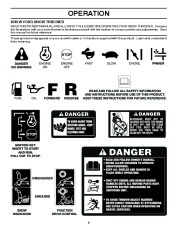 Poulan Pro Owners Manual, 2010 - 8 of 44
Poulan Pro Owners Manual, 2010 - 8 of 44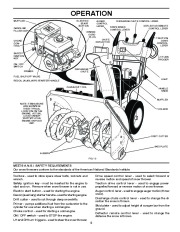 Poulan Pro Owners Manual, 2010 - 9 of 44
Poulan Pro Owners Manual, 2010 - 9 of 44 Poulan Pro Owners Manual, 2010 - 10 of 44
Poulan Pro Owners Manual, 2010 - 10 of 44